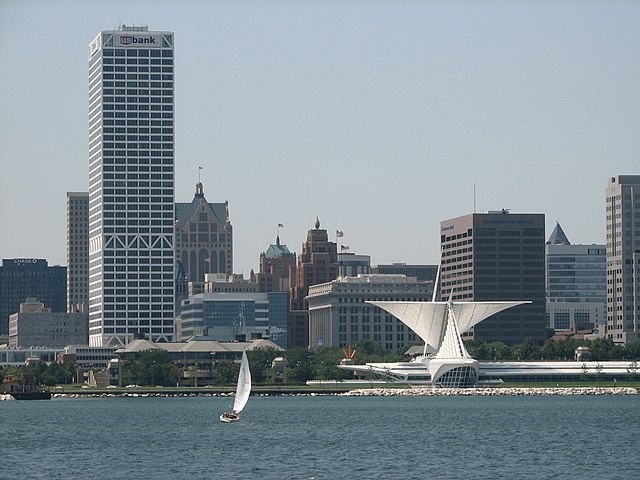Milwaukee metropolitan area
Metropolitan area in Wisconsin, United States From Wikipedia, the free encyclopedia
Metropolitan area in Wisconsin, United States From Wikipedia, the free encyclopedia
The Milwaukee metropolitan area (also known as Metro Milwaukee or Greater Milwaukee) is a major metropolitan area located in Southeastern Wisconsin, consisting of the city of Milwaukee and some of the surrounding area. There are several definitions of the area, including the Milwaukee–Waukesha–West Allis metropolitan area and the Milwaukee–Racine–Waukesha combined statistical area. It is the largest metropolitan area in Wisconsin, and the 39th largest metropolitan area in the United States.
Milwaukee Metropolitan Area | ||
|---|---|---|
| Milwaukee–Racine–Waukesha, WI Combined Statistical Area | ||
 | ||
 Map of Milwaukee–Racine–Waukesha, WI CSA
| ||
| Coordinates: 43°15′00″N 88°10′00″W | ||
| Country | ||
| State | ||
| Largest city | Milwaukee | |
| Other cities | - Waukesha - West Allis - Kenosha - Whitewater - Elkhorn - Lake Geneva - Beaver Dam - Watertown - Fort Atkinson - Mequon | |
| Area | ||
| • Total | 3,356 sq mi (8,690 km2) | |
| Population (2010)[1] | ||
| • Total | ||
| • Density | 464/sq mi (179/km2) | |
| GDP | ||
| • MSA | $120.563 billion (2022) | |
| Time zone | UTC−6 (CST) | |
| • Summer (DST) | UTC−5 (CDT) | |
| Census | Pop. | Note | %± |
|---|---|---|---|
| 1840 | 5,948 | — | |
| 1850 | 69,820 | 1,073.8% | |
| 1860 | 128,653 | 84.3% | |
| 1870 | 157,687 | 22.6% | |
| 1880 | 206,397 | 30.9% | |
| 1890 | 318,065 | 54.1% | |
| 1900 | 405,198 | 27.4% | |
| 1910 | 511,194 | 26.2% | |
| 1920 | 624,109 | 22.1% | |
| 1930 | 821,566 | 31.6% | |
| 1940 | 876,954 | 6.7% | |
| 1950 | 1,014,211 | 15.7% | |
| 1960 | 1,278,850 | 26.1% | |
| 1970 | 1,403,688 | 9.8% | |
| 1980 | 1,397,143 | −0.5% | |
| 1990 | 1,432,149 | 2.5% | |
| 2000 | 1,500,741 | 4.8% | |
| 2010 | 1,555,908 | 3.7% | |
| 2020 | 1,574,731 | 1.2% | |
| 2022 (est.) | 1,559,792 | −0.9% | |
| U.S. Decennial Census[3] 1790–1960[4] 1900–1990[5] 1990–2000[6] 2010–2014 | |||
The U.S. Census Bureau defines the Milwaukee Metropolitan area as containing four counties in southeastern Wisconsin: Milwaukee and the three WOW counties: Ozaukee, Washington, and Waukesha. The Metropolitan population of Milwaukee was 1,575,179 in the Census Bureau's 2019 estimate, making it the 39th largest in the United States.[8]
The city of Milwaukee is the hub of the metropolitan area. The eastern parts of Racine County, eastern parts of Waukesha County, southern part of Ozaukee County, southeastern part of Washington County, and remainder of Milwaukee County are the most urbanized parts of the outlying counties.
The character of the area varies widely. Mequon, Brookfield, and the North Shore (Fox Point, Whitefish Bay, River Hills, Shorewood, Glendale, and Bayside) are more white-collar, while West Milwaukee, West Allis, and St. Francis are more blue-collar.[citation needed]
Metro Milwaukee draws commuters from outlying areas such as Madison, Chicago and the Fox Cities. It is part of the Great Lakes Megalopolis containing an estimated 54 million people.
The Milwaukee–Racine–Waukesha Combined Statistical Area is made up of the Milwaukee–Waukesha–West Allis Metropolitan Statistical Area (Milwaukee, Waukesha, Washington and Ozaukee counties), the Racine Metropolitan Statistical Area (Racine County), the Beaver Dam Micropolitan Statistical Area (Dodge County), the Watertown-Fort Atkinson Micropolitan Area (Jefferson County), and the Whitewater-Elkorn Micropolitan Area (Walworth County) according to the U.S. Census.[9] Updated definitions released in February 2013 added Dodge, Jefferson and Walworth Counties to the Milwaukee CSA. Kenosha, despite being just 32 miles from Milwaukee and 50 miles from Chicago, is included as part of the Chicago CSA, as Kenosha has more residents who commute to the Chicago area. As of the 2019 census estimates, the Milwaukee–Racine–Waukesha Combined Statistical Area population was 2,047,966, the largest in Wisconsin and the 33rd largest in the United States.[8] The Milwaukee-Racine-Waukesha CSA shares an eastern border with the Madison MSA the Janesville-Beloit MSA which in turn are both a part of the Madison CSA.
There are eight counties in the U.S. Census Bureau's Milwaukee–Racine–Waukesha Combined statistical area.


Although each county and its various municipalities are self-governing, there is some cooperation in the metropolitan area. The Milwaukee Metropolitan Sewerage District (MMSD) is a state-chartered government agency which serves 28 municipalities in the five counties.
At the same time, some in the area see the need for more consolidation in government services. The Kettl Commission and former Wisconsin Governor Scott McCallum have supported initiatives to do this. However, full consolidation has faced unsubstantiated criticism as a means of diluting minority voting power.
Seamless Wikipedia browsing. On steroids.
Every time you click a link to Wikipedia, Wiktionary or Wikiquote in your browser's search results, it will show the modern Wikiwand interface.
Wikiwand extension is a five stars, simple, with minimum permission required to keep your browsing private, safe and transparent.